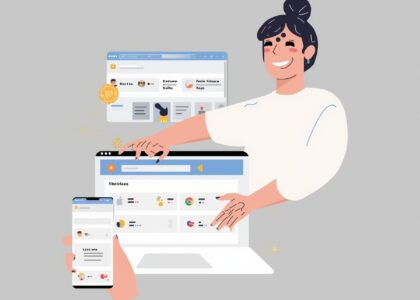You’ve done this before—you look at a product online, maybe a pair of sneakers or a kitchen gadget, then you close the page. Later, you’re scrolling on Facebook or Instagram, and there it is again—the same product. You think, “Wow, they’re everywhere!” That’s retargeting.
If you’re running an online store in the U.S., don’t panic when visitors leave without buying. It happens all the time. Maybe they got distracted, maybe they weren’t ready to spend money yet. Retargeting funnels give them a gentle reminder: “Hey, your item’s still here when you’re ready.”
What Retargeting Funnels Really Are
Retargeting funnels are just a way to bring people back. Here’s how it works:
-
Someone visits your online shop.
-
They like a product but leave.
-
Your ad follows them—on Facebook, Instagram, or Google.
-
They see it again, remember you, and come back to buy.
I first saw this with a friend who runs a small T-shirt shop online. He was worried because people clicked but didn’t buy. Then he tried retargeting ads. Within a week, some of those same visitors came back and ordered shirts. It wasn’t magic—just a smart reminder.
Why Retargeting Works for Small eCommerce Stores
Here’s why retargeting is powerful:
-
Most people don’t buy the first time—they need a second look.
-
Seeing your brand again builds trust.
-
You can show them the exact product they viewed earlier.
-
It costs less than finding brand-new customers.
Think of it like saying, “Hey, remember that thing you liked? It’s still waiting for you.”
Best Places to Use Retargeting
You don’t have to be a tech expert. Start with:
-
Facebook and Instagram – Great for reaching everyday shoppers.
-
Google Ads – Your products can show up across websites and searches.
-
Email – Send a friendly reminder if they left items in their cart.
-
Pinterest or TikTok – Perfect if your products are very visual or for younger audiences.
How to Build a Simple Retargeting Funnel

1. Install Tracking Tools
Add a small code like Facebook Pixel or Google Tag Manager to your website. It helps track who visited your shop.
2. Create Groups of Shoppers
Not everyone is the same. Separate them into groups:
-
People who just browsed.
-
People who added items to their cart but didn’t check out.
-
Past customers who might buy again.
3. Make Friendly Ads
Don’t sound like a big corporation. Use natural language: “Your item’s waiting—grab it before it’s gone!” Use clear pictures and keep your message short.
4. Test Different Ads
Run two ads with different images or wording. See which one works best. This is called A/B testing, but really, it’s just trying different ideas.
5. Spend Small at First
Start with a small budget, like $10–$15 a day. Increase only when you see results.
Tips to Get Better Results
-
Offer a small discount or free shipping to encourage them.
-
Update your ads every few weeks so people don’t get bored.
-
Use customer reviews or ratings to build trust.
-
Avoid showing the same ad too many times—it can annoy shoppers.
Mistakes to Avoid
-
Forgetting past customers—they’re more likely to buy again.
-
Using complicated words or jargon in your ads. Keep it simple.
-
Ignoring your ad performance. Always check your sales and clicks.
Conclusion – Bring Back Your Visitors Without Stress
Retargeting funnels for eCommerce are an easy way to boost sales without chasing brand-new customers. These shoppers already know your product—they just need a little push. Start small, keep your ads friendly, and stay consistent. Even a small online store in the U.S. can see big results by using retargeting to bring visitors back to buy.
FAQs
What is a retargeting funnel?
It’s a method to remind people who visited your shop to come back and buy.
Is retargeting good for small U.S. businesses?
Yes, even small online shops or Etsy stores can use retargeting.
Which platform is easiest for beginners?
Start with Facebook and Instagram—they’re beginner-friendly and popular.
How much budget should I start with?
Start small, around $10–$15 a day. Increase only if you see good results.
Do I need to hire a marketer?
Not at the beginning. You can learn the basics yourself and hire help later if your store grows.




